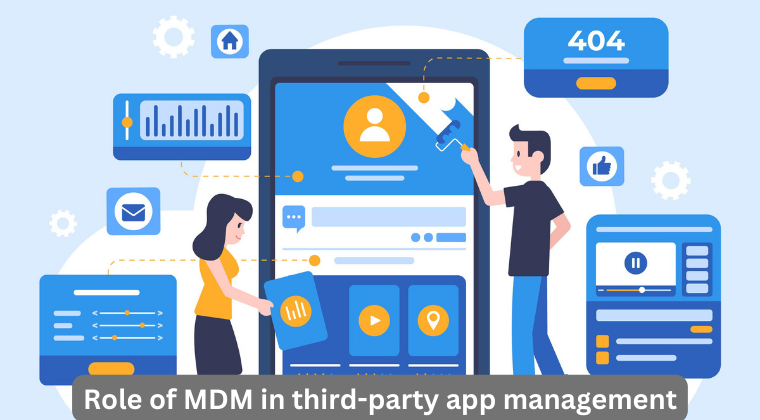Role of MDM in Third-Party App Management

The ever-growing reliance on mobile devices has improved our personal and professional life to a great extent. To fulfill specific business needs, organizations rely on third-party apps as they provide extended functionality tailored according to the requirements.
However, on the flip side, it poses serious security issues as it extends the attack surface of an organization which can be misused by bad actors to launch a cyberattack.
It is important to keep in mind that updating these third-party apps is a deterring task but is significant to secure the threat landscape of an organization.
The role of Mobile Device Management is important in this regard as it streamlines and automates the process of third-party app management. This in turn mitigates security attacks to a great extent.
What is Third-Party App Management?
This process is all about identifying and covering the security issues present in third-party apps. Such apps are developed by some third-party vendors and extend the functionalities of digital devices. However, for proper functioning, these third-party apps need to be updated to overcome security-related concerns, compatibility issues, and other software bugs.
Without adopting a proper patch management plan, third-party apps present serious security issues which put sensitive information and services of an organization at stake.
Significance of Third-Party App Patch Management
The app patch management process is quite important as attackers are on a continuous hunt to exploit vulnerabilities. According to a report by IBM, it takes 212 days (about 7 months) to detect a cyber breach on average and 75 days (about 2 and a half months) to contain it.
So, during the span of 287 days (about 9 and a half months), adversaries can easily steal all the confidential information of customers, trade secrets, marketing plans, tender information, and bidding details which is enough to harm any organization. The only way to protect an organization is by devising an effective third-party app patch management process.
Role of MDM in Patch Management
Mobile Device Management, also known as MDM, provides a comprehensive approach to managing hundreds of devices in a corporate remotely. It allows IT teams to configure settings, install updates, enforce policies, troubleshoot devices, and distribute apps remotely.
Therefore, it can be considered a viable solution to update third-party apps. The following are some of the ways in which MDM solutions can help.
Maintain App Inventory
The first step in third-party app management is to make an inventory of all the external apps used by an organization along with their version. Such a comprehensive list of apps assists IT admins to identify outdated apps version so that they can prioritize the patching process depending on the criticality.
Monitoring Updates
Once you make an inventory of apps, the next important step is to keep an eye on updates. For that, admins can make use of different patch management software and vulnerability scanners. Moreover, software vendors notify users of the updates as well.
Verification of Patches
It is another important step of third-party app management. Before installing patches, it is important to verify them in a controlled environment. This helps in identifying anomalies, security issues, or other compatibility issues before deploying them on original devices.
Prioritization of Updates
Once the patches are verified and secure, the next important step is to prioritize these updates depending on the severity of vulnerabilities and the loss they can bring to the organization if get exploited. This helps the admin to patch the critical security issue as soon as possible.
Automated Deployment of Patches
Using an MDM solution, admins can automate the process of patch installation to hundreds of devices at a time using the centralized console. The admins can choose the time to install patches so that the work of employees does not get disturbed while maintaining the standard of security.
Rollback
In case some security issue got ignored during this process, then the MDM solution also allows admins to roll back patches so that employees’ devices remain secure and stable.
Reporting
The last step of this patch management process is reporting to ensure compliance with internal and external regulations and relevant security standards. The MDM solution allows admins to track the status of patching so that apps ensure optimal security levels and conform to organizational policies and regulatory requirements.
MDM can play a strong role in patch management. However, you must choose the software that is best suited for your needs. Also, you can use MDM for various other purposes as well to manage your business and bring it to progress.